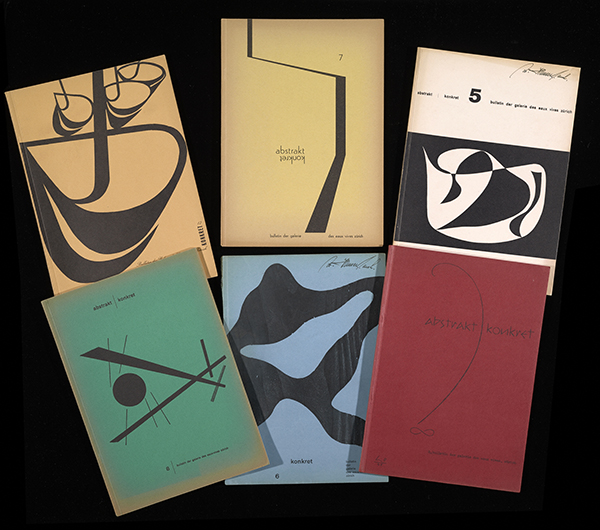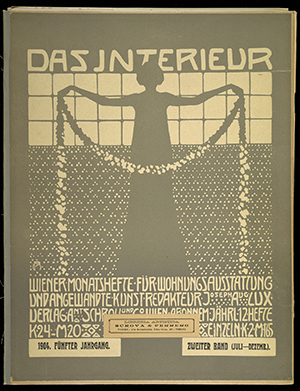Two rare sets of monthly art journals join the special collections of the Getty Research Institute

Selection of issues of Abstrakt-Konkret, published by the Galerie des Eaux-Vives (based in Zurich), issued from 1944-1945. The Getty Research Institute
At the turn of the 20th century, a new art movement had firmly taken hold in Europe. Known as Jugendstil in Germany and Art Nouveau in France, it was inspired by natural forms and structures, taking cues from flowers and plants and making abundant use of curved lines. Jugendstil was an interdisciplinary movement—encompassing everything from painting and graphic art to architecture and interior design. The Getty Research Institute has recently acquired a rare, nearly complete set (missing only one volume) of the journal Das Interieur: Wiener Monatshefte für Angewandte Kunst. Published in Vienna from 1900 to 1913 (and again in 1915), this monthly journal promoted the Jugendstil (Art Nouveau) aesthetic in central European architecture, furniture, and interior design.
Drawings and photographs of designs by leading modern architects and designers—including Vienna Secessionists Josef Hoffman, Koloman Moser, Joseph Maria Olbrich, and Josef Urban—depicted shops, offices, cafes and restaurants, and home interiors and furniture. Addressing an audience of architects and affluent clients, Das Interieur also included architectural plans, elevations, and cross sections embedded in the articles.

Cover, Das Interieur, 1904, Vol. 5, Part 2 (July–December). The Getty Research Institute, 88-S330
The Research Institute has shown a keen interest in collecting turn-of-the-century art from Vienna, which attracted talented visual artists and architects, and has built a strong collection in this area. “Though not very large, the collection of Jugendstil material we have amassed is very rich and deep,” says Nancy Perloff, associate curator at the GRI. “Our collection includes journals, the two programs for the Cabaret Fledermaus [a cabaret venue in Vienna] that include poetry, plays, and references to architecture and set design, as well as a trove of books containing patterns for the design of textiles and graphic art such as prints and posters. Das Interieur will expand on this purview by looking at the ways in which rooms were both designed and furnished in early twentieth-century Vienna.”
In the mid-20th century, a style quite unlike Jugendstil developed: Concrete Art. Instead of the curving, natural patterns presented in the Art Nouveau style, concrete art is abstract and mathematically precise. The Dutch De Stijl artist Theo van Doesburg coined the term “Concrete Art” to describe an approach to abstraction that emphasized materiality, structure, and unity of form as concrete elements in themselves, free of any symbolic association. The Research Institute’s special collections now include a rare, full set of the bulletin Abstrakt Konkret, Bulletin der Galerie des Eaux-Vives, issued from October 1944 to October 1945 by the Galerie des Eaux-Vives, Zürich, which provides crucial documentation of the beginnings of the Concrete Art movement in Europe. Abstrakt Konkret served as the voice of the Swiss avant-garde artists’ group Allianz, of which Max Bill—the principal theorist of the movement—was a member, helping to spread the style internationally. The bulletins contain hand-signed illustrations and important texts by Swiss artists, as well as essays by theorists of Concrete Art. Many articles are among the first in Europe to address the movement and therefore mark an important period for the Swiss avant-garde. There are only two other known complete sets of the bulletin, both in Switzerland.
“Whereas Das interieur enhances the Research Institute’s wealth of documentation on Viennese decorative arts and design, Abstrakt Konkret lays the theoretical basis for the concrete art movement,” explains Nancy. “It will offer researchers a crucial context for the international movement of concrete and visual poetry, which became so important in the postwar years. In addition, there is not a lot of information on the Allianz group, which created the bulletin. This acquisition will help address that void.”

Poetamenos (Minuspoet), #6, 1953, Augusto de Campos. The Getty Research Institute
Concrete poetry, which grew out of the concrete art movement, is also an important collecting area for the Research Institute. Swiss poet Eugen Gomringer, whose work is included in the collections, described a concrete poem as “an object to be seen and used. . . a reality in itself and not a poem about something or other.” He emphasized the distinct and self-sufficient quality of the concrete poem, calling it a “functional object,” where the physical aspect of the words and their layout are the defining characteristic, rather than the content of the poem. Experiments with visual poetry abound at the Research Institute.
Both journals are currently being catalogued and will be available for study next spring.




Comments on this post are now closed.